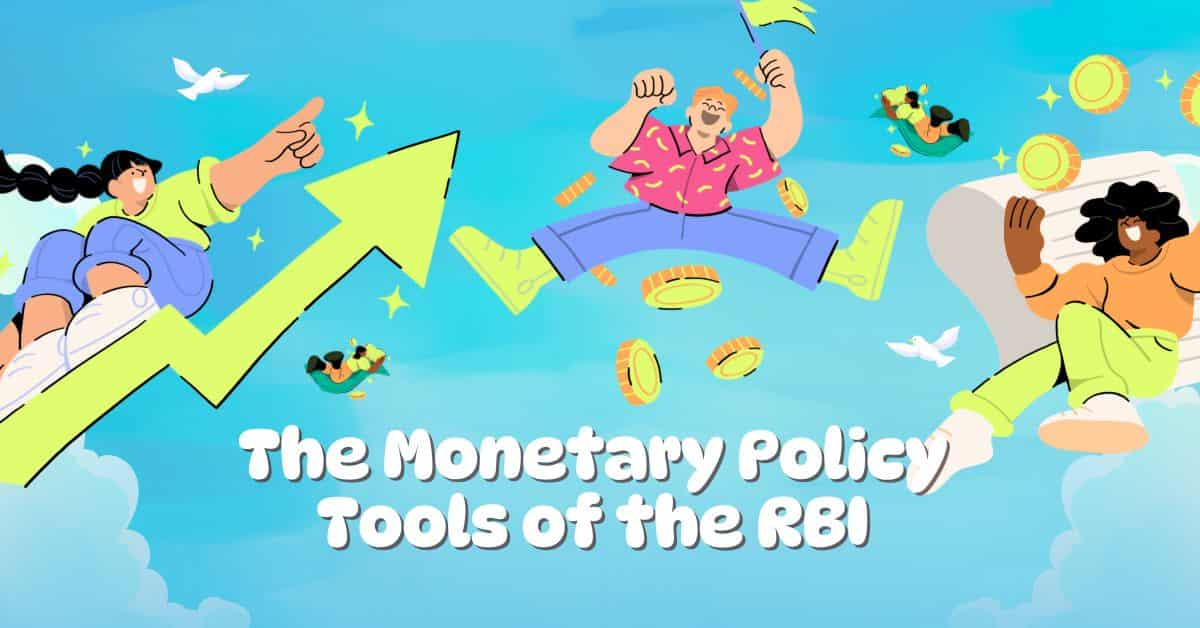RBI Monetary Policy: Understanding the Reserve Bank of India’s (RBI) monetary policy is like studying the rules of the financial game for a college graduate or young professional looking to invest in India. Your investments in stocks, bonds, mutual funds, and fixed deposits are all directly impacted by the RBI’s choices, which also influence inflation, interest rates, and economic growth. For example, a shift in the repo rate may have an impact on whether your home loan becomes more affordable or your stock portfolio increases. The RBI kept the repo rate at 5.5% as of August 2025, indicating a cautious approach in the face of international trade risks such as U.S. tariffs on Indian goods. This guide covers the fundamentals of the RBI’s monetary policy, how it affects your investments, and provides helpful advice for navigating the market with assurance in 2025.
What is Monetary Policy?
The RBI uses monetary policy to control interest rates and the money supply in order to govern the economy. Its main objectives are:
- Price Stability: Maintaining price stability is keeping inflation within a predetermined level, which for India is usually 4% ± 2%.
- Economic Growth: Promoting employment and commercial ventures.
- Currency stability: Currency stability refers to preserving the value of the Indian rupee both nationally and internationally.
The Monetary Policy Committee (MPC), a six-member body headed by Governor Sanjay Malhotra, helps the RBI accomplish these goals. It meets every two months to examine economic indicators such as GDP growth, inflation, and the dynamics of international trade. The repo rate will remain at 5.5% until August 6, 2025, when decisions are made and publicised in bi-monthly remarks [The Hindu BusinessLine].
The Monetary Policy Tools of the RBI
The RBI employs a number of instruments to impact the economy, each of which has a unique impact on investments:

1. Rate of Repo
The interest rate at which the RBI loans commercial banks short-term funding is known as the repo rate. In order to stimulate growth, it was lowered from 6% in June 2025 to 5.5% as of August 2025 [Times of India]. While a higher rate decreases inflation but may hamper economic activity, a lower repo rate lowers borrowing costs and promotes investment and expenditure.
2. Rate of Reverse Repo
In August 2025, the RBI set its borrowing rate from banks at 5.25%, which is 25 basis points lower than the repo rate. By encouraging banks to lodge money with the RBI, it reduces lending capacity and manages the surplus money supply.
3. The ratio of cash reserves (CRR)
The percentage of a bank’s deposits that it is required to retain with the RBI is known as the CRR. To increase lending, the RBI announced in June 2025 a 100 basis point CRR drop that will be phased in between September and November 2025 ([India Infoline]([invalid url, do not cite])). A lower CRR stimulates the economy by making more money accessible for lending.
4. The SLR, or Statutory Liquidity Ratio
A portion of banks’ net demand and time obligations must be held in liquid assets, such as government securities, according to the SLR. It guarantees banks have emergency cash on hand, but it restricts excessive lending.
5. OMO, or open market operations
To modify the money supply, the RBI purchases or sells government securities. Purchasing securities helps manage inflation or liquidity by bringing money into the economy and withdrawing it when they are sold.
For Indian investors who want to make smart decisions, it is crucial to comprehend the monetary policy instruments available to the RBI. With the Repo Rate at 5.5% as of August 2025, bank borrowing costs have an impact on lending rates and stock market fluctuations. At 5.25%, the reverse repo rate controls excess liquidity in the financial system and influences banks’ ability to lend. Loan availability and economic development will be directly impacted by the progressive reduction in the cash reserve ratio (CRR) that takes place between September and November 2025. Although it restricts the amount of money available for lending, the fluctuating Statutory Liquidity Ratio (SLR) guarantees bank liquidity. Last but not least, interest rates and bond yields are impacted by the money supply being adjusted through OMO (Open Market Operations).
Monitoring these policy changes is an essential component of smart financial planning for investors as it enables them to forecast trends in the debt, stock, and real estate markets.
The Impact of Monetary Policy on the Economy
Your investments are impacted by the RBI’s instruments, which have an impact on the entire economy:
- Interest rates: By lowering lending and deposit rates, a lower repo rate encourages investment from businesses and consumer spending. Higher interest rates make borrowing more expensive, which might impede growth.
- Inflation: The RBI’s inflation objective is 4% (±2%). Due to consistent demand and favourable monsoons, it predicted FY26 inflation in August 2025 to be 3.7%, down from 4% [Business Standard]. While high inflation reduces purchasing power, low inflation increases it.
- Economic Growth: In spite of international trade obstacles including U.S. tariffs, the RBI maintained a 6.5% GDP growth prediction for FY26, indicating confidence in domestic spending [Moneycontrol]. Contractionary policies prevent overheating, whereas expansionary policies (such as rate decreases) promote growth.
Why Should New Investors Care?
Your investment returns are directly impacted by monetary policy:
- Stock Markets: Companies’ borrowing costs are decreased by lower rates, which raises earnings and stock values. For instance, equities rallies were probably aided by the 50 basis point drop in June 2025 [India Infoline]. Increased rates may cause values to decline.
- Bond Yields: The relationship between bond prices and interest rates is inverse. Existing bond prices decline when interest rates rise, which affects fixed-income portfolios. Lower rates increase the value of existing bonds while decreasing the appeal of new ones.
- Currency Value: While lower rates may weaken the rupee and impact import-heavy industries like oil, higher rates draw in foreign investment and boost it.
- Sector Impacts: Interest-sensitive industries like banking, real estate, and autos profit from low rates. For example, by maintaining constant house loan rates, the August 2025 neutral position promotes housing demand [The Hindu BusinessLine]. Bank FDs and other fixed-income assets are favoured by high rates.
August 2025: Recent Updates on Monetary Policy
Following a 100 basis point reduction from 6.5% to 5.5% since February 2025, the RBI’s MPC, led by Governor Sanjay Malhotra, maintained the repo rate at 5.5% with a neutral stance on August 6, 2025 [Times of India]. Important points to note:

- Inflation forecast: 3.7% for FY26, down from 4%, owing to favourable monsoons and stable demand.
- GDP Growth: Maintained at 6.5% thanks to strong investment and consumption.
- Global Difficulties: The RBI adopted a cautious stance because to concerns about U.S. tariffs (25% on Indian exports) and India’s dependence on Russian oil [Business Standard].
- CRR Cut: To increase lending, a 100 basis point decrease would be implemented gradually between September and November 2025 [India Infoline].
If inflation stays under control, a possible 25 basis point rate drop is expected at the next MPC meeting in October 2025 [Moneycontrol].
Practical Tips for New Investors
Use these easy-to-follow guidelines to take advantage of RBI monetary policy for more intelligent investing:
- Monitor RBI Announcements: For updates on rates and economic projections, follow the bi-monthly MPC meetings (next: October 2025) on [RBI’s official site] or [Moneycontrol].
- Start Small: To find out how the market would respond to changes in policy, invest ₹5,000 to ₹10,000 in diversified mutual funds like [Groww]or [Zerodha].
- Diversify Your Portfolio: To control risks, strike a balance between equities, bonds, and fixed deposits. As an example, invest more in stocks during low-rate environments and choose FDs during high-rate ones [ET Money].
- Recognise Sector Impacts: Make investments in industries that stand to gain from changes in policy. High rates increase fixed-income assets (Financial Express), whereas low rates favour banking (e.g., HDFC Bank) and real estate (e.g., DLF).
- Keep Up to Date: To keep track of economic news and the consequences of policy, use applications like [ET Money] or [Moneycontrol]. To receive information in real time, follow RBI on social media.
Frequently Asked Questions (FAQs)
1. What is the monetary policy of the RBI?
The RBI uses interest rate and money supply management as part of its goal to stabilise the currency, encourage growth, and limit inflation [RBI].
2. What is the impact of the repo rate on my investments?
While higher rates favour fixed-income assets, lower repo rates (such as 5.5% in August 2025) increase stock values and loan affordability [Business Standard).
3. Why is monetary policy important to new investors?
It affects your returns by affecting sector performance, bond yields, and stock prices [The Hindu BusinessLine].
4. When is the next RBI policy meeting?
Updates are available on [Moneycontrol]or [RBI’s site]as of October 2025.
5. How can I start making policy-based investments?
Make tiny investments, diversify, open a Demat account with [Zerodha], and speak with a financial advisor [Groww].
An Example from Real Life
The scenario is that Arjun, a 24-year-old Mumbai student who makes ₹40,000 a month, wants to invest but isn’t clear how RBI regulations would influence his decisions.
- Action: Arjun follows the RBI’s August 2025 decision on [Moneycontrol], pointing out that the 5.5% repo rate helps banking and real estate stocks. He invests ₹5,000 in a Nifty Bank ETF, establishes a Demat account with [Groww], and initiates a ₹2,000 monthly SIP in a diversified equities fund. He diversifies with a ₹10,000 fixed deposit and utilises [ET Money] to keep an eye on policy changes.
- Result: Arjun would have gained ₹600 if the Nifty Bank ETF increases by 12% by December 2025, making his initial investment of ₹5,000 ₹5,600. His multifaceted strategy balances risk and reward and is consistent with the RBI’s impartial position.
Conclusion
For new investors in India, it is essential to comprehend the monetary policies of the RBI. You can make more informed investment decisions if you understand how instruments like the repo rate (5.5% in August 2025), CRR, and OMO affect interest rates, inflation, and growth. Although the RBI’s recent neutral stance and 6.5% GDP prediction indicate stability, caution is necessary due to global uncertainty. Diversify your holdings, start small with sites like [Groww] or [Zerodha], and keep an eye on [Moneycontrol] for changes. To customise your approach and take advantage of chances in 2025, speak with a financial advisor!
Disclaimer: There are risks associated with investing, and previous performance does not guarantee future outcomes. Before making any investing decisions, get advice from a licensed financial advisor. This article is for educational purpose only.
PNB Housing Share – Will It Double Your Money in 2025
GNG Electronics IPO: Investor Guide for 2025
Gold Investment for Beginners in India – Safe Ways to Get Started

I’m Rashid Ali, a personal finance blogger and content creator at SavingSecret.in, helping young adults in India master saving, investing, and tax planning. I simplify money topics like budgeting, IPO updates, and stock market tips to make finance easy and actionable. Follow me for smart money moves that actually work!
